Recent Articles
The Point: a Franco-American Heritage Site in Salem, Massachusetts
Traditional French Songs in Ontario
Fort William, Crossroad of a Fur Trading Empire
The Guigues Elementary School in Ottawa
Centre franco-ontarien de folklore (CFOF)
Centre de recherche en civilisation canadienne-française (CRCCF)
Articles
-
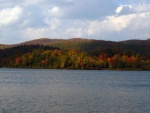
Emblematic Landscapes of Lac-Tremblant-Nord: Natural Scenic Area and Cultural Heritage Asset
Lac Tremblant is well-known due to its proximity to Mont Tremblant, which looms over it. The uniqueness of the site resides in the fact that, historically, the land use of Lac Tremblant has long been split into two subdivisions, which is reflected in the area's distinct landscapes. The southern part of the lake and the mountain have been turned into a world-renowned recreation area, whereas, since the beginning of the 20th century, the northern segment has been protected as a natural heritage scenic area, a fact which is evident in natural features of the region. In this way, the Municipality of Lac-Tremblant-Nord has preserved and carefully shaped the landscapes that now have become such a part of its distinct unique identity, a uniqueness that, for the local residents, is so much a part of what makes them proud to live there. From the earliest days, this natural scenic heritage, with all of its age-old evocative power, has been a protected area; long before such conservation measures were the norm. Today, however, it is now being threatened.
-

Alexis Lapointe, a.k.a. Alexis le Trotteur (1860-1924): the Man, the Legend
Alexis Lapointe, known as "LeTrotteur", "le Cheval du Nord," the "Surcheval," and the "Centaur", was the subject of both admiration and mockery in his day. Over the course of his lifetime, he remained a simple labourer, an odd man whose tomfoolery brought joy to those around him. In death, however, he became a mythical figure, a legendary athlete the likes of which he himself would never have imagined. And what can be said about the exhumation of his remains from a cemetery in La Malbaie in November 1966, 42 years after his death? What about the exhibition of his skeleton in museums throughout the Saguenay for 35 years? This poor fellow seems to have become more famous in death than in his life.
-

Anticosti National Park
With the creation of Anticosti National Park in 2001, this wilderness area was officially preserved as part of the Province of Quebec's natural heritage. The park includes the Vauréal Falls Area, which is considered to be a place of extraordinary natural beauty meriting public protection and government recognition. Anticosti is however so much more than the sum of its physical and natural features. It is impossible to fully grasp the ramifications of the park's newly acquired heritage status without taking into consideration the various social factors involved, as well as island's history of human inhabitation. When examined from this perspective, Anticosti becomes a model example of the inextricable relationship between humans and their environment, which are key elements essential to the process of protecting and promoting natural areas in the Province of Quebec.
-

Baie-Ste-Marie (Nova Scotia) Eudists
In 1890, the Eudists [Congregation of Jesus and Mary] arrived from France to set up an educational institution for Nova Scotian Acadians of Baie Sainte-Marie [St. Mary's Bay]. They also took charge of two parishes in the region. Over the decades that followed (mainly until the 1970s), members of the Congregation would fill the roles of educator, religious community builder, administrator, writer, and even nationalist. Their presence at Point-de-l'Église [Church Point] is an example of a cross-cultural encounter between the French and Acadian communities that left its mark on the region on architectural, cultural, and religious levels. The gradual transition from being a congregation consisting mostly of French priests to one staffed almost entirely with Canadian clergy created a balance between these two cultural factions within the institution. Over the years, the Eudist contribution to the Nova Scotian French-speaking community's heritage has been expressed in a wide variety of ways.
-

Baron of Lahontan
After having enjoyed a considerable success in Europe with the 1702-1703 publication of his three-volume memoire - mainly inspired from his long stay in New France (1686-1693) - Lahontan was all but forgotten for more than two centuries. Then his works were rediscovered in the 1970s, and subsequently came to be considered essential, as they offered a better understanding of the literary evolution of the travel literature genre, as well as of the libertarian movement that swept over Europe during the age of Enlightenment of the 18thcentury. His work is also thought to be an invaluable contribution to the history of New France. Lahontan, an antihero who was not nearly as publicised as Champlain or other legendary characters of New France, has produced a work that today still assists scholars in better understanding French cultural heritage and history.
-

Blacksmith’s Trade in the Province of Quebec
In recent years, there has been a veritable renaissance in the traditional blacksmith's trade, especially with regard to art metal work, decorative wrought iron and the restoration of historic buildings. Some interpretation centres even offer visitors and neighbouring communities a range of useful products made to order by artisan blacksmiths. It is impossible to fully appreciate the re-emergence of these almost forgotten practices without first understanding the long and storied history of blacksmithing in Quebec, which was marked by a continuous evolution of trade practices and techniques that started back in the days of New France. It is also important to point out the resilience of the blacksmiths despite the many threats to their trade: harsh working conditions, fickle economic cycles, the dawn of industrial mass production after 1850 and the advent of the automobile in the early 20thcentury.
-

Chicoutimi Pulp Mill
A treasure among Quebec's cultural heritage assets, the Pulperie de Chicoutimi [Pulp Mill] is without a doubt one of the province's unique sites. The mill is a rare example of mechanical [rather than chemical] pulping process used in the early days of the region's pulp wood industry. For this reason, in 1983, both the federal and provincial governments granted the site historical monument status, largely as a result of public efforts to see the site granted official recognition. In true French architectural tradition, the mill is built of natural stone, a beautiful and durable choice of materials. Archives document how over several generations site has been put to multiple uses reveal; not only do they describe the day-to-day activities at the location, but also how the mill was built, how it changed hands and how it was transformed into a museum for cultural and touristic purposes.
-

Claude Le Sauteur (1926-2007): the Enlightened Artwork of a Lighthouse Keeper
Head and shoulders above the rest; that is quite possibly the most defining characteristic of the figures found in the works of artist and painter Claude Le Sauteur (1926-2007). Although the faces can seem vague and even ill-defined at first glance, the head dominates nonetheless. It is neither tortured nor fractured. There is no veneer of surrealism; the artist's every move is composed and calculated. The tone is just right. The keen mind of a lighthouse keeper knows how to observe. Claude le Sauteur was both renowned and subtle, well-loved by both the great and small of the land. The colours found in his depictions of Quebec's landscapes, scenes and heroes are vibrant, yet soothing. Like a lighthouse keeper, Claude Le Sauteur had his eye set on the horizon, and now many are seeking to understand his stunning perspective on a facet of our national and regional history that, up until now, has almost been entirely ignored.
-

Daniel Johnson Dam and the Manic 5 Generating Station—Symbols of Modernity in Quebec
The Daniel Johnson dam and the Manic 5 generating station, a hydroelectric complex located 214 km north of Baie-Comeau in the Côte-Nord region of Quebec, remain strong symbols of Quebec’s hydraulic wealth and technical prowess for a majority of Quebec’s citizens. The emblematic power of these facilities might be summed up in the expression “We can do it after all!” NOTE 1 On the one hand, this treasure of Quebec’s heritage—the world’s largest multiple-arch and buttress dam—is the expression of undeniable know-how put into action by the engineers of Hydro-Québec and Quebecois engineering consultants. On the other hand, this hydroelectric complex, more than any other, embodies a society that has definitively reclaimed control of development of its primary source of wealth—namely, its hydraulic resources—for the improvement of the greater common good.
-

Félix Leclerc, Québec’s pioneering singer-songwriter
Félix Leclerc, already a highly-acclaimed author in the early 1940s, and well-known in particular for his trilogy, Adagio, Allegro and Andante, did not initially see himself as a singer-songwriter or chansonnier. The reason was simple: the French Canadian literary establishment saw no inherent value in the poetic character of Leclerc’s few early musical texts. For the literary pundits of the time, such songs could at best be considered in the same category as French music hall ditties, a genre they considered frivolous, or else folk music, which they looked down on. It was the response in France to Félix Leclerc’s songwriting and performing style that transformed perceptions of his “poetry given voice”. Leclerc was a pioneer who opened the way for the concept of “songs with content”, and in fact gave legitimacy to this way of singing which would become so popular in France, in Québec and all across French Canada.
-
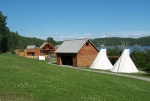
Fort Témiscamingue on Obadjiwan Point: a Place for Meeting and Exchange
The Fort Témiscamingue-Obadjiwan National Historic Site of Canada illustrates the important role the fur trade once had in the Canadian economy. It also testifies to the Franco-British rivalry for control of the fur industry. The industry also played a key role in defining the cultural perception the inhabitants of the Témiscamingue region had of themselves, regardless of whether they were Native Anishinabe (Algonquin) or French or English settlers. The Témiscamingue site has been a centre of human activity for about 6,000 years and various peoples have used it as a meeting place for making exchanges: the Anishinabe; the English and French voyageurs (NOTE 1) who plied the fur trade; as well as the French Canadian settlers of the Témiscamingue region. Today the site is a tourist attraction jointly managed by Parks Canada and the Timiskaming First Nation. This partnership is based on an agreement that is on the verge of being finalized. The objective of the project is to offer visitors a multi-cultural interpretation program.
-

Fortress of Louisbourg: from History to Historic Site
Standing on a low-lying peninsula along the north-eastern shore of Cape Breton Island, the Fortress of Louisbourg seems to rise right out of the sea when approaching by water. Coming by land along Route 22 from Sydney this picturesque complex of fifty or so buildings that appear to have survived from another era is equally impressive. Once close enough to make out the details, visitors see that the ensemble is nearly surrounded by fortifications, an 18th-century set-piece that looks as if it has been there for centuries. It hasn't, of course. For this is the Fortress of Louisbourg, a fortified town-site that is a one-fifth reconstruction of what had once stood on that very spot: the 250-buildings ville fortifiée erected by French colonists between 1713 and 1745. The goals of the ambitious Canadian reconstruction project of the second half of the 20th century, built between 1961 and 1982, were to create a major cultural tourism attraction in Atlantic Canada and to encourage interest and pride in a then little-known part of Canadian history.
-

From Repression to Preservation of the French Language
The early years of the 20th century were difficult for French-speaking communities of Louisiana. Starting in 1915, for the first time, with industrialization proceeding apace and, above all, with French-speaking children being compelled to go to school in English, the culture and language of these communities were threatened. Thus, French usage gradually fell away and was lost to entire generations. In 1968, a portion of the community took action, establishing the Council for the Development of French in Louisiana (CODOFIL), an organization with the stated mission of reintroducing French into the school curriculum and supporting francophone culture in Louisiana. While this organization is not without its critics, its work has helped to achieve major advances towards preservation of French language and culture. Videographer Helgi Piccinin gathered a variety of accounts on this fundamental aspect of Louisiana’s francophone heritage.
-
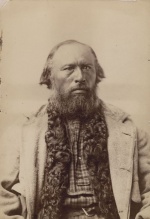
Gabriel Dumont, the Last of Great Métis Leaders
North America's Métis nation was born out of the meeting of the First Nations and European settlers between the 17th and the 18th centuries. Gabriel Dumont, along with his friend Louis Riel, are emblematic figures for this unique people group. He took up arms to fight for their rights at the battle of Batoche in 1885. He also spoke for them in New England and in Quebec, where, in 1888, he sought to present the French Canadian Métis as the civilisers of the Prairies. Even today, his leadership skills, his loyalty, his ability to make decisions and his exceptional determination are an inspiration to the many Métis community organisations in Canada and the United-States. Gabriel Dumont's actions have helped give the Métis people their rightful place at the heart of French cultural heritage of North America.
-

Jacques Cartier
Jacques Cartier was among a group of explorers who left Spain, Portugal, England and France in the 16th and 17th centuries, mainly in search of a passage towards the elusive and mythical China. Cartier became one of the "discoverers" of the New World, an immense pair of continents now called the Americas, which blocked the path of all the navigators to the Far East. He was a meticulous explorer who mapped out a vast territory extending from the Gulf of St. Lawrence to the village of Hochelaga (present-day Montreal), all of which he claimed for the King of France. Cartier did not however manage to found a permanent colony. During the 19th century, the first historians of French Canada proclaimed Jacques Cartier the discoverer of Canada, for the idea of a French discoverer served the emerging nationalist interests very well indeed.
-

La Rochelle and French North America
La Rochelle’s history is the history of its various ports, which manifest La Rochellers’ ability to embrace the changing dynamics of the Atlantic seaway in the 12th through the 18th centuries. La Rochelle’s early involvement in the great discoveries and its commerce with the Americas and the rest of the world—determined by the whims of colonial shipping companies and economic opportunities—established this port town as one of the major seaboard towns of the Atlantic realm. La Rochelle’s story goes way back! It is not surprising to find, in La Rochelle and the surrounding territory (greater La Rochelle today boasts a population of nearly 150,000) and in the urban landscape of the old town, the traces of the French adventure in North America—an adventure of Franco-Quebecois cooperation that continues to this day in many forms.
-

La Troupe du Jour, Saskatoon’s Professional French-Speaking Theatre Company
As its first French-speaking communities began to be established, Saskatchewan's first French-Speaking theatre company emerged at the beginning of the 20th century. But it has only been since 1985 that the province has had its very own professional French-speaking theatre company. La Troupe du Jour has taken upon itself to become a centre of artistic creativity in Western Canada. As a result, the group played a major role in the creation of a community of Fransaskois artists. Over the course of its existence, the company has staged a number of original works, as well as classics taken from the vast repertoire of French language literature. In 2003, La Troupe du Jour was inducted into the Margaret Woodward Theatre Hall of Fame.
-

Lac-Saint-Jean «Tourtière»
Tourtière [a specialty meat pie from the Lac-Saint-Jean region] is undoubtedly the dish that is most emblematic of the Province of Quebec. Although it is less a part of the daily diet today than in previous decades, it is still served and enjoyed on special occasions-particularly during the holiday season. Nonetheless there is an ongoing debate between those who consider the Lac-Saint-Jean recipe as the only authentic tourtière and those who consider the tourtière to simply be a modest-sized dish that closely resembles the traditional meat pie. In fact, the typical Lac-Saint-Jean tourtière consists of a rolled-dough bottom crust placed in a large relatively deep casserole dish which is then filled with pieces of meat and sometimes potatoes and finally covered with a dough crust. The "tourtière/meatpie", on the other hand, is a much simpler dish composed of a top and bottom crust filled with a ground beef preparation. Despite their differences, these two versions of the tourtière share a common origin that goes back quite a long ways. Over the centuries, the two types of tourtière have often crossed paths, thereby creating a strong Quebec culinary tradition.
-
Métis Trails of Western Canada
On the 17th of February 1997, a plaque was unveiled atthe Alberta Legislature in Edmonton. Simultaneously, the same event was being commemorated at the Fort Garry Hotel in Winnipeg. Members of the Métis Nationof Alberta and Manitoba as well as representatives of the Ministry of CanadianHeritage and local historic associations came together on that day ofcelebration. No monument was inaugurated and no tribute was paid to any personin particular. Instead, these representatives were gathered to underline thenational historical importance of the Carlton Trail, a transportation routethat marked the development of the Northwest during the 19th century.
-

Mid-Lent Traditions in Acadia
The Mid-Lent celebration remains a vibrant living tradition in several Acadian regions of Eastern Canada. In Cheticamp and Saint Joseph du Moine on Cape Breton Island, in Fatima on the Magdalen Islands, and in Natashquan and Pointe-Parent in Quebec's Côte Nord region, the annual Mid-Lent outing is a rich tradition that has survived since the arrival of the first settlers. On Prince Edward Island, in the Tignish and Palmer Road parishes, a number of families have kept alive another tradition: the annual visit of the mysterious Mi-Carême [Mid-Lent] a mythical [female] figure who brings sweets to well-behaved children. These communities have maintained traditions of French origin formerly known throughout Acadia as well as in a number of regions of the Province of Quebec.
-

Montreal Canadiens; a Religion
The Université de Montréal announced in January 2009 it would offer a 16-week graduate course to future clerics called "The Religion of the Montreal Canadiens," and instead of poking fun at the ivory tower of academia, the media took the question quite seriously. Two months later, when word came out that the cash-strapped American owner of the Canadiens had put the team up for sale, the news was met with even more serious soul searching, if not a widespread spiritual crisis. The speculation was that Quebec-based saviours such as Cirque du Soleil's Guy Laliberté and René Angelil would come to the rescue of the faith. In a short time, these two events suggested that the Canadiens were much more than a hockey team, but rather, an essential component of Quebec identity in the way the Catholic Church used to be. The Canadiens' very existence provides a meaning of life for millions - for the game, its heroes and their fans do indeed make up a sort of "secular religion".
-
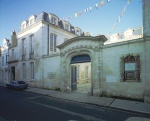
Musée du Nouveau Monde, La Rochelle, France
Housed in a magnificent 18th century private residence, Musée du Nouveau Monde’s collections tell the story of France’s relations with the Americas as conducted from La Rochelle, one of the main ports of New World trade and migration. Paintings, engravings, old maps, sculptures, furniture and decorative art objects conjure up images of Canada, the West Indies, and Brazil as well, with records of the transatlantic slave trade. A section is also devoted to the indigenous peoples of North America and the Far West.
-
Nuit sur l’Étang: a Nocturnal Frenzy of Franco-Ontarian Partying
In March of 1973, a few students from Laurentian University in Sudbury (Ontario), under the supervision of Professor Fernand Dorais, organized an event showcasing a variety of artists to be held at the end of the conference. A number of Franco-Ontarian musicians, performers, and poets took to the stage of the Fraser Auditorium to provide a memorable evening of entertainment. And so, Nuit sur l'Étang [A Night at the Pond] was born. More than 35 years have passed since that first night, yet the event still attracts a regular audience. In spite of many difficulties and changes over the years, Nuit sur L'Étang has continued to pursue its original goal of showcasing up-and-coming artists, while offering Franco-Ontarians an occasion to celebrate. On one evening a year, people from all over the province rally together to celebrate what has been called the "collective Franco-Ontarian frenzy." (NOTE 1)
-

O Canada: From French Canadian Patriotic Song to National Anthem
Every country has a national anthem, and Canada—with its O Canada—is no exception. National anthems are symbols meant to bring people together, crystallizing their sense of belonging and collective identity. Played or sung at official ceremonies and on solemn occasions, they are supposed to encapsulate what is best in a country or nation. That, in theory, is their purpose. But the destiny of an anthem may change over time to reflect transformations in a country or nation. Such is the surprising story of O Canada. A French Canadian patriotic song before becoming Canada’s national anthem, it is a fixture at sporting events like professional hockey games and the Olympics, yet opinion is still divided on its importance as a symbol of identity. Today, the role of this 19th century song remains the subject of debate and reconsideration.
-

Orléans: A Franco-Ontarian Suburb
In a mere forty years Orléans has gone from an overwhelmingly French-speaking village to a suburb of Ottawa where scarcely one-third of the population has French as its mother tongue. Nonetheless, the French presence remains vibrant and local francophones are exceptionally dedicated to preserving their language and culture and building on their achievements. No other place in Ontario boasts cultural programs and facilities like those that serve Orléans’ francophone community. The fight twenty years ago to have the provincial government spell “Orléans” with the accent on the “e” is an eloquent example of the community’s determination to stand up for its rights with regional and provincial authorities.
-

Ottawa Through the Eyes of Franco-Ontarian Writers
Ottawa may be Canada’s capital, but it is a much smaller city than Montreal or Toronto, both of which once vied to take its place. As a smaller centre, it also garners less attention in Franco-Ontarian literature—less than Toronto, Montreal, or even Quebec City. Despite this, Ottawa has carved out a respectable niche, often as a target of gentle irony, if not outright satire. Such, at least, is the portrait that emerges from the writings of various journalists, novelists and short story writers over more than a century.
-
Parc national du Mont Tremblant
The wildnature of Parc National du Mont-Tremblant [Provinical Park] draws visitors to the region year-round. With mountains, 400 lakes, six rivers and stands of fir and pine trees as far as the eye can see, the 1,510-km2 [583 square-mile] park features broad scenic vistas of Laurentian landscape. From the time it was founded as a forest reserve in 1895 and when it was finally recognised as a national park in 2001, the park has been subject to several changes over the years, whether it be to its boundaries or its land use. Throughout the park's history, the use of its forests and wildlife has reflected the evolution of the cultural and economic values of the society that created it.
-

Pointe-au-Père Navigational Aid Centre
Designated a national historic site by the Government of Canada in 1974, the Pointe-au-Père Lighthouse, several kilometres east of Rimouski, was recognized “because of its historic role as an important pilotage service centre” and “because it was an important beacon for navigation on the gulf and river”. With this designation, the centre became a memorial site and it has continued to evolve over the 35 years of its existence, as various stakeholders have identified and developed a sense of ownership in it. A notable addition to the Pointe-au-Père Lighthouse was a museum, providing a venue for assembling and displaying in their original setting collections mainly associated with the maritime history of the Lower St. Lawrence and Quebec.
-
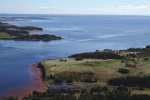
Port-la-Joye – Fort Amherst: A Colonial Outpost in an Island Setting
Port-la-Joye – Fort Amherst National Historic Site of Canada is located near Rocky Point off Route 19 on the south shore of Queen’s County, Prince Edward Island. Visitors to the site will encounter the grass-covered earthworks of Fort Amherst, erected by the British in 1758, as well as an indication of the location of some of the structures associated with the earlier Port-la-Joye – a French colonial outpost and one of the Island’s first permanent European settlements. This includes the excavated foundation of the house belonging to Michel Haché dit Gallant and his wife, Anne Cormier, who were among the first Acadians to settle on Prince Edward Island.
-

Quebec Beer, Brewers and Breweries
Beer is the most popular alcoholic beverage in Canada and Quebec. Beer drinking as a tradition dates back to the days of New France, making brewing one of the oldest trades practiced in the Lawrence Valley. However, both brewing practices and the popularity of beer underwent significant changes, as the British tradition began to have a strong influence on the beer industry through the establishment of the first large-scale modern-day brewery, the Molson Brewing Company. The Industrial Revolution made it possible for beer to become a mass-produced commodity, brewed and bottled in factories and distributed by increasingly sophisticated infrastructures. Nowadays, microbreweries have revived the practices of artisanal brewing, as a number of festivals celebrate the many varieties of this ancient beverage.
-

The Cercle Molière: for the Love of Theatre in French
Every year without fail, since 1925, the Cercle Molière [Molière Circle] has presented theatre in French in Winnipeg, Manitoba. The Circle is recognized as Canada's oldest theatre company of any language and represents one of the finest French culture treasures that has roots in Western Canada. Originally operated by passionate amateur theatre lovers, the Circle is now a professional company. It offers a program for adults and another for younger audiences, as well as providing training sessions in the dramatic arts. The Circle is a major monument to local heritage and is a key player on Manitoba's French-language arts and culture scene. It has always been a rallying point for the energies of the Franco-Manitoban community, which has often helped it overcome the many obstacles that it has had to face.
-

The Heritage of Métis Language in Western Canada
The second half of the 18th century saw the emergence of two distinct communities in the fur trade territories known as the Pays d’en haut: the French-speaking Métis and the English-speaking Métis known as “halfbreeds.” Both communities were born of the unions of aboriginal women and white men. The French or English that Métis children learned from their fathers evolved over time to give rise to two local dialects: French Michif and Bungee, a vernacular form of English. But these children had also learned their mother’s aboriginal languages. They would create a whole new language, Michif, a remarkable blend of French, Cree and Ojibwa. Today, this remarkable linguistic heritage is threatened with extinction.
-
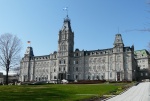
The Parliament Building of Quebec: A Place of Memory
Erected between 1875 and 1886, the Quebec Parliament Building stands as one of the finest examples of Quebec’s architectural heritage. Its craftsmanship and style evoke the past, present and future of a nation committed to democracy. And its imposing freestone façade, distinctive silhouette and interior design all bring to mind—as its architect Eugène-Étienne Taché intended—the French origins of this North American nation. The building’s east-facing façade, just a stone’s throw from the fortifications of the Old City, is adorned with a series of sculptures that hearken back to significant events and figures in the founding of Canada and Quebec. Carved above the main entrance is Quebec’s motto, “Je me souviens.” A reference to Quebec’s evolution since 1534, the motto actualizes political history and reminds observers that to this day the parliament is the seat of the people’s assembly and their elected government.
-
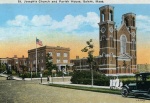
The Point: a Franco-American Heritage Site in Salem, Massachusetts
Salem, Massachusetts is a cultural palimpsest, a geographical space that bears traces of communities of people who have called this city their own. French-Canadians, who immigrated to Salem in the late 19th and early 20th centuries, made their mark in a neighborhood called “The Point.” A devastating fire razed the neighborhood in 1914, forcing its French-Canadian and Franco-American inhabitants to reimagine and rebuild it. One hundred years later, the Point was named to the National Register of Historic Places in the United States due to the uniformity of its architectural style and its cultural importance to Salem’s Franco-American community.
-
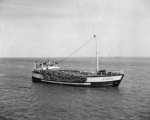
The schooner Saint-André, a jewel of the Charlevoix Maritime Museum
The schooner Saint-André was built in 1956 at La Malbaie, in Charlevoix County, by master carpenter Philippe Lavoie, one of the last schooner builders of the Saint Lawrence. Its owner, Captain Fernand Gagnon, engaged in coastal trading on the Saint Lawrence, mainly between Montreal and Sept-Îles, until 1976. At that time wooden schooners were replaced by metal ships, which were much larger, more profitable and better adapted to winter navigation. The Saint-André, one of the last witnesses to Quebec's particular long maritime tradition, was classified as a cultural property in 1978. Recently restored, it is conserved at the Charlevoix Maritime Museum, near the shores where it was born.
-

Toponymy of the Churchill River: a Legacy of the French-speaking Voyageurs
Over 347 kilometres (215 mi) long, the Churchill River is the location of multiple exceptional natural, cultural and historical heritage sites. In fact, there are so many important sites in the Churchill River Basin that it has been proposed as a candidate for the Canadian Heritage Rivers System. Churchill's history has been marked by the forays made by various voyageurs involved in the fur trade. They gave the Churchill waterway and the surrounding region all kinds of French names. These names testify to the veritable golden age of the French language in a region that would later come to be known as Saskatchewan.
-

True Portrait of Marguerite Bourgeoys
The post-mortem portrait of Marguerite Bourgeoys is the only surviving contemporary depiction of one of the most remarkable figures in the history of Montreal during the 17th century. Painted in 1700 by Pierre Le Ber, the work has been in the hands of the Congregation of Notre-Dame ever since and is currently exhibited at the Marguerite Bourgeoys Museum. During the 19th and early 20th centuries, the portrait was retouched several times, completely altering its appearance. The restoration of the painting in 1963-1964 revealed the true face of Marguerite Bourgeoys and the authentic work of one of Canada's earliest painters.
-
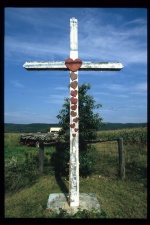
Wayside Crosses
Nearly3,000 wayside crosses are still standing along the highways and byways of theProvince of Quebec. They representa precious heritage-a legacy of the past. The first crosses were erected by Jacques Cartier as a symbol ofterritorial appropriation. Later,the pioneers used them to mark the founding of a village and French Canadianpeasant farmers (then known as habitants) did thesame upon staking their land claims. All sorts of reasons have led French Canadians to put up waysidecrosses: farmers set them up closeto their fields for divine protection; parish priests erected them to indicatethe site of a future church; parishioners raised them up on the halfway pointalong a concession or range road, where they would gather for the eveningprayer. Although wayside crossesare first and foremost religious objects, over time they have taken on a moreheritage-oriented significance, their distinctive outline characterising aparticularity of the Quebec countryside that has come to be associated with thefaith of the French Canadian forefathers.
Images
-

58_Cheval_du_Nord.jpg
Article :
Alexis Lapointe, a.k.a. Alexis le Trotteur (1860-1924): the Man, the Legend -

"Chevreuil" ou Cerf d
'Anticosti, Poi...Article :
Anticosti National Park -

Denis Tardif signant
le transfert de...Article :
Association Canadienne Française de l’Alberta (ACFA) -

J.H. Picard
Article :
Association Canadienne Française de l’Alberta (ACFA)
-

Ancienne résidence du
gouverneur, si...Article :
Beauregard Town District of Baton Rouge, Louisiana -

1912-2007
Article :
Boulevard Saint-Laurent: the Very Essence of Montreal -

Mère Canada avec vue
au nord, 2007Article :
Canadian National Vimy Memorial -

Affiche du colloque L
es autres litté...Article :
Centre de recherche en civilisation canadienne-française (CRCCF)
-

Plaque du Cercle des
Fermières de Ha... -

Tapis crocheté acadie
n à motif de co... -

Orignal, 1972
-
Vue de Montréal vers
le nord-ouestArticle :
Coverdale Collection
-

Aiguille à filet
-

Alène et fil de cordo
nnier traité au... -

André Benoit, Betsiam
ites, 1965 -

Appeau à cerf et boît
ier
-

Appeau en bois
-

Bonhomme Lacombe, 198
1 -

Bûcheron et traîneau,
1961 -

Carquois (avec épingl
e à ressort), a...
-

Chicane de truites, 1
981 -

Coffret de peintre de
Paul Provenche... -

Côte Nord, non datée
-

Couteau croche
-

Gobelets de bois
-

Grattoir en os de car
ibou -

Groupe de femmes mont
agnaises et leu... -

Huard en vol,1979
-

Ile à Smith, 1976
-

Île aux oeufs, Côte-N
ord, 1978 -

Indien avec canot, 19
77 -

La baie de Kécarpoui,
en Basse-Côte-...
-

La Montagnaise suspec
te de Sept-Iles... -

Mocassin haut confect
ionné en cuir, ... -

Montagnaise tissant r
aquette, 1967 -

Ouananiche naturalisé
e de la rivière...
-

Paquebot sur mer, 196
5 -

Passerelle des draveu
rs, 1971 -

Rapide du Grand Nord
en 1930, 1980 -

Rivière aux Outardes
en 1935, 1980
-

Rivière Rouge (Côte-N
ord), 1962 -

Rivière Toulnoustook,
1976 -

Sac à outils en peau
de caribou -

Tasse de porcelaine
-

Troisième chute La Ma
nic, 1972 -

Vertèbre animale avec
inscriptions à... -

Voilier dans la baie,
1974 -

Carte de la Nouvelle
France contenan...
-
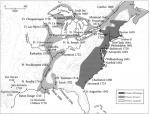
Carte montrant la pré
sence française... -

Les armoiries du Québ
ec dans le vitr... -

École Maurice-Lavallé
e -

Le lac Tremblant et s
es cabanes sert...Article :
Emblematic Landscapes of Lac-Tremblant-Nord: Natural Scenic Area and Cultural Heritage Asset
-

Le logo de la Municip
alité de Lac-Tr...Article :
Emblematic Landscapes of Lac-Tremblant-Nord: Natural Scenic Area and Cultural Heritage Asset -

Colombie britannique
– Yukon – Terri... -

Le 25 octobre 1989, s
ondages archéol...Article :
Fleming Mill -

Le moulin Fleming au
parc Stinson de...Article :
Fleming Mill
Vidéos
-

Entrevue avec Roger Gervais, directeur du Centre franco-ontarien de folklore de Sudbury
Roger Gervais, le directeur général du Centre franco-ontarien de folklore, présente l'histoire et la mission du centre, foncé par le le père Germain Lemieux, grand collecteur de contes, légendes et chansons populaires dans le nord Ontario francophone. Des images de l'abondante collection du Centre (livres, maquettes, dessin) illustrent son propos. Roger Gervais explique également l’évolution récente du Centre et les activités qu’il organise depuis quelques années.
-

Montage présentant les motifs paysagers de Lac-Tremblant-Nord.
Montage réalisé par l'Encyclopédie Durée : 2 min 28
Article :
Emblematic Landscapes of Lac-Tremblant-Nord: Natural Scenic Area and Cultural Heritage Asset -

Zachary Richard s'explique sur le fait de chanter en français (3min38sec)
Être Louisianais francophone, c’est devoir assumer une identité métissée : Louisianaise, Américaine, franco-nord-américaine… « C’est complexe! » Mais la réalité, c’est aussi admettre être en position minoritaire. Pour Zachary, il est inutile de tenter de convaincre la majorité anglophone de devenir francophone. Par contre, ils peuvent devenir francophiles. Montage : Helgi Piccinin. Production : Vidéo Eldorado. Équipe Vidéo Eldorado : - Benjamin Gadoury - Nicola Bannatyne - Helgi Piccinin - Erik Ayotte - François Guinaudeau - Mike Taylor - Lucie Zappa. - Morgane Stein - Frank Trudel - Céline Jaegler
Article :
Festival International de Louisiane -

Maurice Richard
(Film muet) Ce film présente quelques images de la partie du 19 octobre 1957 entre les Canadiens et les Blackhawks de Chicago et, tout particulièrement le moment où Maurice Richard marque son 500e but devant des partisans soulevés par cet exploit mémorable du Rocket. L’événement est ensuite souligné par le président de la Ligue, Clarence Campbell, en présence de plusieurs coéquipiers, dont Émile « Butch » Bouchard et son frère Henri Richard ainsi que l’entraîneur Toe Blake. En 1972, Richard devient l’entraîneur-chef des Nordiques de Québec et prend part au premier match hors-concours de l’équipe dans la nouvelle Association mondiale de hockey tenu à Baie-Comeau.
Article :
Maurice Richard, the Hockey Player (part 1) Maurice Richard, the Legendary Figure (part 2) -
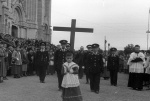
Pèlerinage à Sainte-Anne-de-Beaupré
Au début des années 1920, la basilique de Sainte-Anne-de-Beaupré est déjà l’un des principaux lieux de pèlerinage en Amérique du Nord, renommée pour ses miracles. De nombreux fidèles viennent s’y recueillir et implorer les faveurs divines. Après l'incendie de 1922, la Basilique est reconstruite progressivement aux dimensions d’aujourd’hui, ce qui en fait l’une des plus grandes églises du Québec. Les pèlerins continuent de fréquenter la basilique en grand nombre lors du grand pèlerinage annuel, où l’on bénit les malades, et de cérémonies diverses.
-

Mise en lecture de Ti-Jean & et le nénuphar de la destinée
Rachel Desaulniers, l'auteure de la pièce pour enfants «Ti-Jean et le nénuphar de la destinée», raconte son processus de création et les objectifs qu'elle poursuivait en écrivant cette pièce basée sur les contes recueillis par le père Lemieux dans le nord de l'Ontario. On voit aussi des extrait de la première mise en lecture de cette pièce, qui a eu lieu à Sudbury, en 2010. La metteure en scène, Marie-Josée Dionne, explique dans quel esprit elle a conçu cette mise en lecture et de quelle façon elle a travaillé avec les comédiens Alain Lauzon et Anie Cousineau. Les projets de tournée évoqués par l'auteure se sont réalisés au printemps 2012.
Documents sonores
-

Entrevue avec R. Outhet
Entrevue réalisée par Fabienne Joliet et Louise Royer Fabienne Joliet interroge M. Rickson Outhet sur la période où son grand-père s'est établi avec quelques autres personnes sur les rives du lac Tremblant-Nord. M. Rickson Outhet raconte dans quel esprit des professionnels et des artistes, surtout anglophones, ont vécu et séjourné dans ce havre naturel, puis comment la communauté de Lac-Tremblant-Nord a évolué. Durée de l'extrait : 6 min 10
Article :
Emblematic Landscapes of Lac-Tremblant-Nord: Natural Scenic Area and Cultural Heritage Asset
Documents PDF
-
Extrait du roman Le Cheval du Nord de Marjolaine Bouchard (Éditions JCL, 1999)
Taille: 44 Kb
Article :
Alexis Lapointe, a.k.a. Alexis le Trotteur (1860-1924): the Man, the Legend -
Extraits de la charte de la municipalité de Lac-Tremblant-Nord de 1915
Contient les règlements, ordonnances, informations et noms des localités. Taille: 39 Kb
Article :
Emblematic Landscapes of Lac-Tremblant-Nord: Natural Scenic Area and Cultural Heritage Asset -
Annexe Champagne-Ardennes, terre de fondateurs
Informations supplémentaires sur l'abbé Jessé Fléché, premier prêtre séculier d'Acadie, Paul Le Jeune et la fédération des Amitiés Nord-Américaines de Champagne-Ardenne (ANACA).
-
Document de présentation de l'exposition «Paris 1900. Collections du Petit Palais, Paris»
Exposition présentée en exclusivité nord-américaine au Musée national des beaux-arts du Québec, du 4 octobre 2007 au 6 janvier 2008
-
Abondance du pin blanc sur le continent nord-américain depuis la dernière glaciation
Version PDF d’une présentation PowerPoint. Raymond Quenneville, Parcs Canada Taille: 2Mb
Article :
Saving the American White Pine -
«Le peintre du Nord: René Richard de Baie St-Paul» (2 pages)
Article de Gérald Tremblay paru dans L'Action catholique, vol. XXI, no 1, dimanche 6 janvier 1957, p. 1-2.
Article :
René Richard, Landscape Painter














